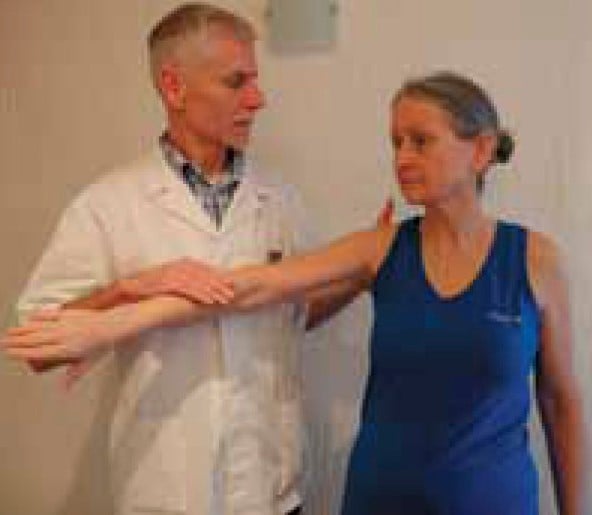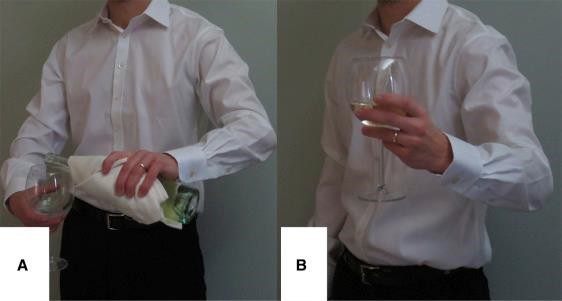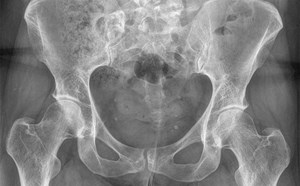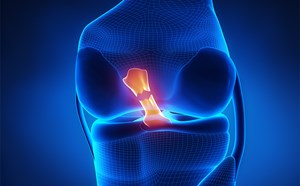
Journal Club: A Toast to a New and Improved Physical Exam Test for the Supraspinatus
The Bottom Line:
The champagne toast sign provides almost 6 times better isolation of the supraspinatus than the Jobe’s or “empty can” test.
Traditionally, the Jobe’s or ”empty can” test has been used to isolate and evaluate the supraspinatus (Figure 1). However, many studies1-7 have demonstrated the test to have very poor sensitivity, specificity, and accuracy. The 90 degree abduction required by Jobe’s test can lead to false-positives in patients with other shoulder disorders and may not isolate the supraspinatus from the abducting force of the deltoid well enough.

Figure 1. Empty Can Test (Courtesy of C. Norris, 2014
Reference: Norris, C. Empty Can Test. Digital Image. SportEX. Flickr. 2014. Web. 6/6/17)
A 2016 translational EMG study out of Chicago proposed a new physical exam technique that they coined the “champagne toast” sign (Figure 2B). Their hypothesis was that a lower degree of abduction would better isolate the supraspinatus from the deltoid since the supraspinatus functions as the initiating shoulder abductor.
10 healthy recreational athletes volunteered for the study. Through EMG analysis, the authors primarily examined the activation of the supraspinatus and deltoid. These muscle groups were studied through a standard shoulder exam as well as isometric resistance test in different degrees of abduction. The abduction was modified with either a relative internal rotation or external rotation of the shoulder.
The results demonstrated that there was a significant difference in activation of supraspinatus compared to deltoid with abduction. In fact, the “empty can” test had the largest activation of the supraspinatus. However, it also had the largest activation of the deltoid. It was the 30 degree abduction that had the greatest activation of the supraspinatus relative to the activation of the deltoid. The “champagne toast” sign (30 degrees abduction, external rotation) was found to be 5.75 times better at isolating the supraspinatus compared to the “empty can” test. A similar “champagne pour” sign (30 degrees abduction, internal rotation) was found to be 5.25 times better than the “empty can”.

Figure 2. A. “Champagne Pour” and B. “Champagne Toast” (from Chalmers, 2016)
Although this study was small, the results were still statistically significant. Among other findings, the biggest one was that there was a significant difference with degrees of abduction. There was no significant difference between external and internal rotation. 90 degrees activates the deltoid too much in relation to supraspinatus activation. This highlights the underlying issue with the “empty can” test. An injured deltoid with a healthy, intact supraspinatus could result in a false-positive. According to these results, it would be better to decrease the degree of abduction to 30 degrees regardless of internal or external rotation.
So, next time you want to evaluate the supraspinatus, try asking your patient to raise a toast instead of pouring soda all over your exam floor.
References:
- Bak K., Sørensen A.K., Jørgensen U., Nygaard M., Krarup A.L., Thune C., et al: The value of clinical tests in acute full-thickness tears of the supraspinatus tendon: does a subacromial lidocaine injection help in the clinical diagnosis? A prospective study. Arthroscopy 2010; 26: pp. 734-742
- Hegedus E.J., Goode A., Campbell S., Morin A., Tamaddoni M., Moorman C.T., et al: Physical examination tests of the shoulder: a systematic review with meta-analysis of individual tests. Br J Sports Med 2007; 42: pp. 80-92
- Hertel R., Ballmer F., Lambert S., and Gerber C.: Lag signs in the diagnosis of rotator cuff rupture1. J Shoulder Elbow Surg 1996; 5: pp. 307-313
- Kelly S.M., Brittle N., and Allen G.M.: The value of physical tests for subacromial impingement syndrome: a study of diagnostic accuracy. Clin Rehabil 2010; 24: pp. 149- 158
- Östör A.J., Richards C.A., Tytherleigh-Strong G., Bearcroft P.W., Prevost A.T., Speed C.A., et al: Validation of clinical examination versus magnetic resonance imaging and arthroscopy for the detection of rotator cuff lesions. Clin Rheumatol 2013; 32: pp. 1283- 1291
- Park H.B., Yokota A., Gill H.S., Rassi El G., and McFarland E.G.: Diagnostic accuracy of clinical tests for the different degrees of subacromial impingement syndrome. J Bone Joint Surg Am 2005; 87: pp. 1446-1455
- Somerville L.E., Willits K., Johnson A.M., Litchfield R., LeBel M.-E., Moro J., et al: Clinical assessment of physical examination maneuvers for rotator cuff lesions. Am J Sports Med 2014; 42: pp. 1911-1919
- Sanchez-Sotelo, Joaquin. "Testing of shoulder strength may identify tears of the rotator cuff". Shoulder & Elbow. December 12, 2016. "https://shoulderelbow.files.wordpress.com/2016/12/testing-of-shoulder-strength-may- identify-tears-of-the-rotator-cuff.jpg?w=748"
- Chalmers, Peter N., et al. "The champagne toast position isolates the supraspinatus better than the Jobe test: an electromyographic study of shoulder physical examination tests." Journal of Shoulder and Elbow Surgery 25.2 (2016): 322-329.
William Denq, MD


